Knife skills can be one of the most intimidating obstacles when learning to cook.
You see some random guy on TV chopping up vegetables blindfolded, and you think to yourself, “Well….sh*t…“.
Exhibit A:
Ignore this! It’s definitely cool to watch, but insane knife skills are not necessary for our purposes.
As a beginner, all you need is some good, basic fundamentals and you are well on your way to cooking some delicious Japanese food.
Having strong fundamentals will help prevent your beautiful knife from getting chipped or damaged. It will also prevent yourself from cutting fingers off and never wanting to cook again.
In this article, we will go over all the basic Japanese knife skills you need: how to stand, how to hold your knife, how to hold the ingredients, and the basic cutting motion.
Japanese Knife Skills – Step 1: Safety / Preparation
First, let’s prepare our equipment. You will need the following:
- A dry cutting board – put a towel or non-slip mat underneath to prevent it from sliding around
- A clean, sharp knife (No knife?? Check out some recommendations)
- Something to cut! Some ideal choices for beginners: cucumber, green onion / spring onion, zucchini, celery
Your cutting board should be placed 2 – 3 centimetres away from the edge of the counter, so there is no risk of it falling off. Don’t place it too far away or you will have to lean/stretch over too much.
When you are not using your knife, place it on the far side of the cutting board with cutting edge facing opposite of you, like so:
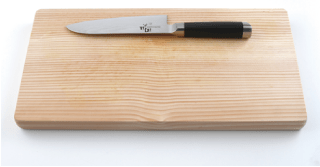
Step 2: Stance / Body Position
Stand with your body a few centimetres away from the counter top. Then, turn your body approximately 45 degrees to the counter/ cutting board (see image below).
Standing at an angle allows you to cut with your knife perpendicular to the board, maximizing use of space. It also allows your hand to be outside the edge of the cutting board, which gives you better knuckle clearance (i.e. you won’t hit your hand on the cutting board when chopping things).
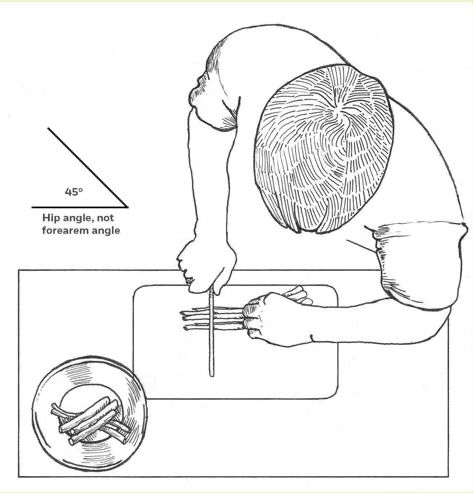
Your body should more or less stay in this same position 90% of time when cutting. If you need to cut ingredients at different angles, you should rotate your ingredients instead of your body or arm.
To get your body at the proper angle, you can try the following:
- Option 1: Stand facing your cutting board. Take a step back with your right foot (if you’re right handed) until your body is at an approximate 45 degree angle.
- Option 2: Stand facing your cutting board. Keeping your left foot straight, take a very tiny step back with your right foot, and rotate it outwards to the right, or until your body is at about a 45 degree angle.
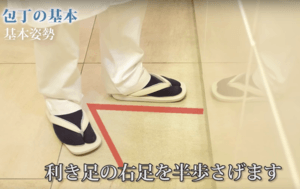
I prefer the second method, as I find there is less tension in my body. But, choose whatever way works for you!
Step 3: How to hold your Japanese knife
There are a couple of recommended ways to hold your knife. It depends a bit on the type of knife you are using, as well as your ingredients and cutting method.
Option 1: The Pinch Grip
This is probably the most typical way to hold a kitchen knife. You will use it 90% of the time.
Pinch the base of the blade between your thumb and side of index finger. The first knuckle of your index finger should always be touching the face of the blade. Then, simply wrap the remaining three fingers around the handle.
It’s a bit weird to explain in words, so here are photos and video/GIF to better illustrate:


Option 2: The Point Grip
The “point” grip is basically the same as the pinch grip, except you place your index finger on the spine of the knife. Like so:

It offers more control over the tip of the knife, so is generally used for delicate / intricate cutting techniques. You will often see this grip used by Japanese chefs when slicing fish or making sushi / sashimi. It is also better suited for longer blades (e.g.: sushi knives / yanagiba).
In the end, the grip you choose is up to you. Practice both methods to see which is more comfortable for you and your knife. There may also be some times when you will need to use a “hammer” grip (i.e. all fingers wrapped around the handle). This method gives less control, but more strength for heavy knives to break down big items like fish heads, etc.
Step 4: How to position your off hand / hold your ingredients
How you hold your ingredients is just as important as how you hold your knife. The generally recommended method for beginners to use is the ‘claw’ technique.
Let’s say you’re cutting up a carrot. Here’s how it should look (instructions below image):
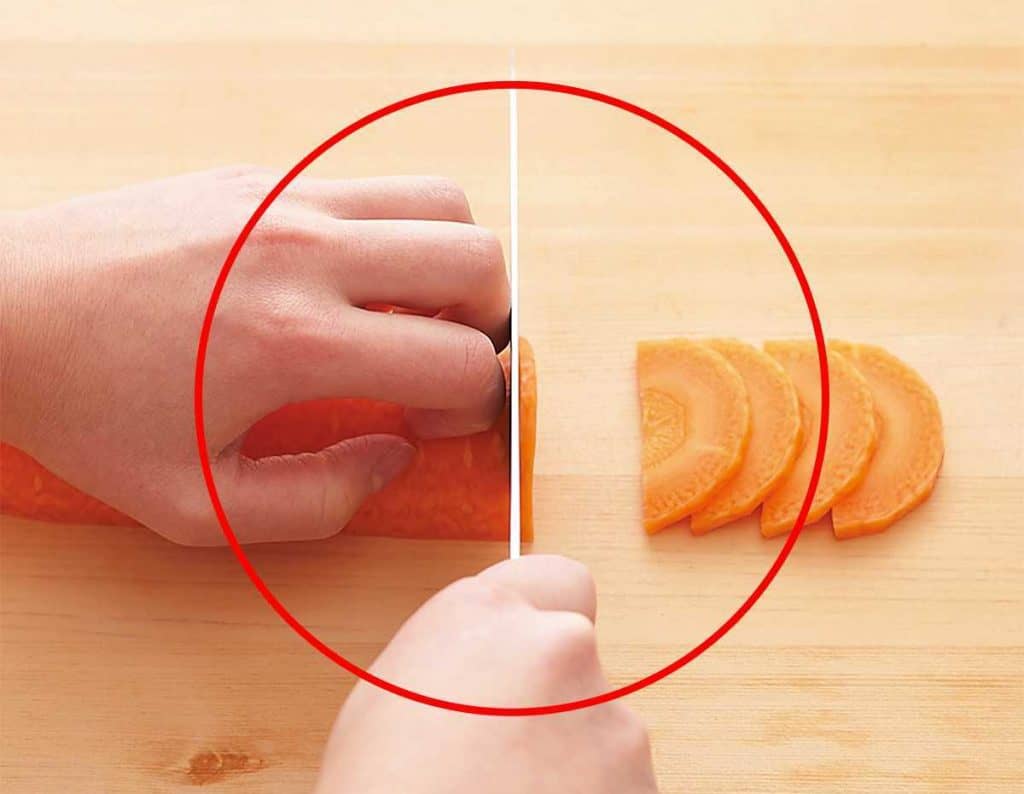
- First, break down your ingredient into a more manageable lengths, so that you can easily handle it with one hand. Probably around 5 – 6 cm is good. If possible, place the flat edge of the ingredient face down so it does not roll around.
- Curl your off hand into a claw so that your finger tips are pointing inward (away from your knife). This will prevent you from chopping your fingertips off.
- The first knuckle of either your middle finger or index finger (but not both) should be in contact with the blade face at all time. I prefer index finger, but it is up to you. Always having your knuckle against the face of the blade helps you aim your cut, and also prevents you from lifting the knife too high.
- Depending on what you are cutting, your thumb should either be:
- a) on the end of the ingredient
- b) curled inwards like the rest of your fingers, and pinching the side of the ingredient
- c) curled underneath your other fingers.
That’s it! Here’s a cool GIF showing the proper holding technique. Notice how this guy uses his index finger to press against the knife blade, while the above image uses the middle finger. Choose whichever is more comfortable for you.

I really like GIFs, so heres another one of a guy using proper holding technique to slice an onion:

Step 5: Cutting motion
The final step. Now that you know how to position yourself, hold the knife, and hold your ingredients, it’s time to actually cut something! Your cutting motion will depend on what you are cutting, and also the shape/profile of your blade.
Method 1: Push cut / Thrust cut
This is the most common method used in Japanese cooking. It is used for cutting most vegetables, as well as other basic ingredients.
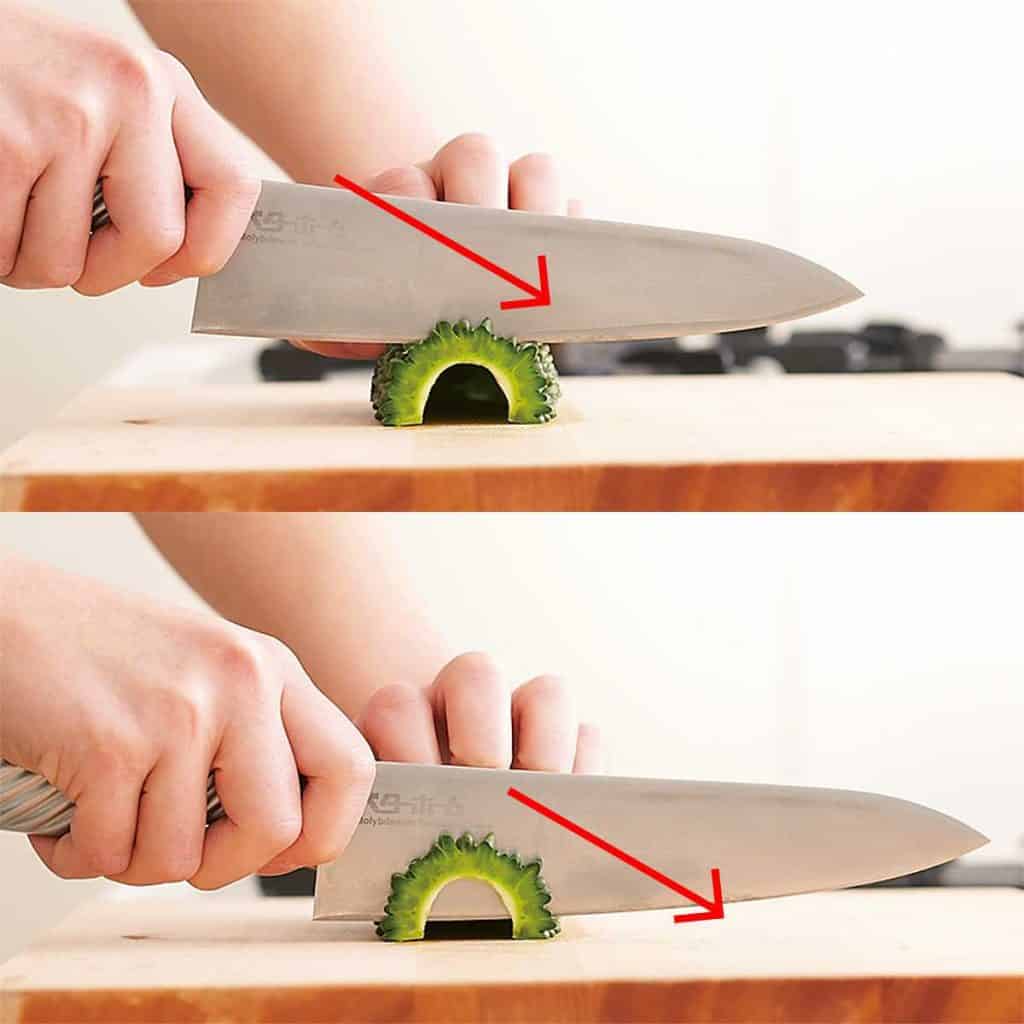
Start with the knife touching the ingredient with the front or middle part of the blade. Then, simply push the knife down and forward slightly away from your body. Slice completely through the ingredient until the blade is touching the board. Lift the blade completely off the board to start a new slice. GIF time:

Since Japanese knives tend to have a flatter profile, the push cut method is preferred over a rocking motion which you often see with more curved blades.
Method 2: Pull Cut
The “pull cut” is commonly used for slicing fish and sashimi. Also, sometimes meats like chicken and beef. As a beginner, you will find yourself using this method less often.
It is basically the opposite of the “push cut”. Start with ingredient touching closer to the base of the blade edge , and pull the knife downwards and towards yourself. The motion should finish at, or near, the tip of the blade. Some chefs will also add a curved slicing motion (see second GIF).


Conclusion
That’s all folks! You now know all the basic knife skills needed to start cooking — how to position yourself, how to hold your knife, how to hold your ingredients, and a couple different cutting motions to use.
Time to start practicing! But, remember — safety first!! Here are a few more tips to help you:
- Take it slow. Don’t try to keep up with the chefs on TV or even your more experienced friends. Focus on getting your technique down before trying to speed up.
- Relax. You don’t need to grip the knife super tight. Try not to have too much tension in your hands or shoulders.
- Don’t lift the knife any higher than necessary. This minimizes risk of accidentally chopping yourself.
- Use a sharp knife. This makes cutting so much easier, and allows you use less force.
- Practice makes perfect. It will be difficult/slow/awkward at first. Try out a couple different hand positions to find what works best for you.
Did I miss anything? How are your knife skills? Let me know in the comments!
Subscribe for free today! Receive cool recipes, my latest Japanese knife picks and learn about Japanese culture. Delivered every other week to your inbox.
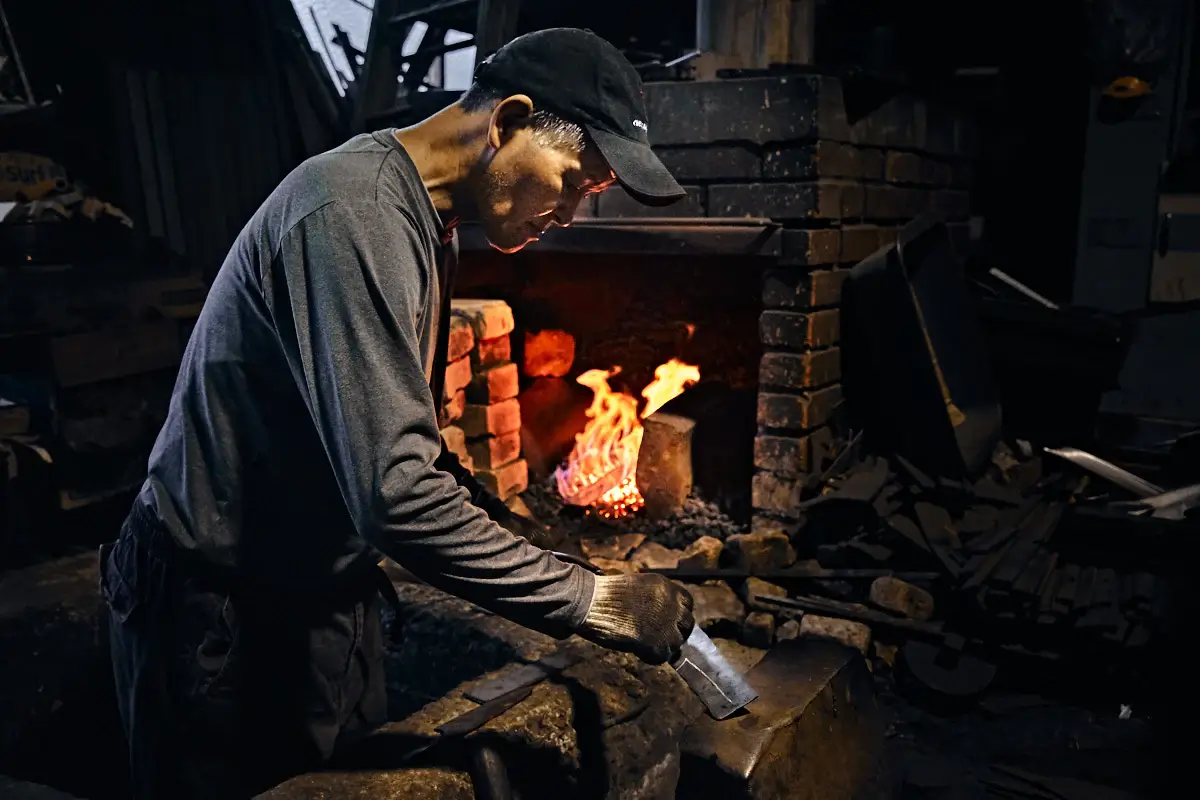
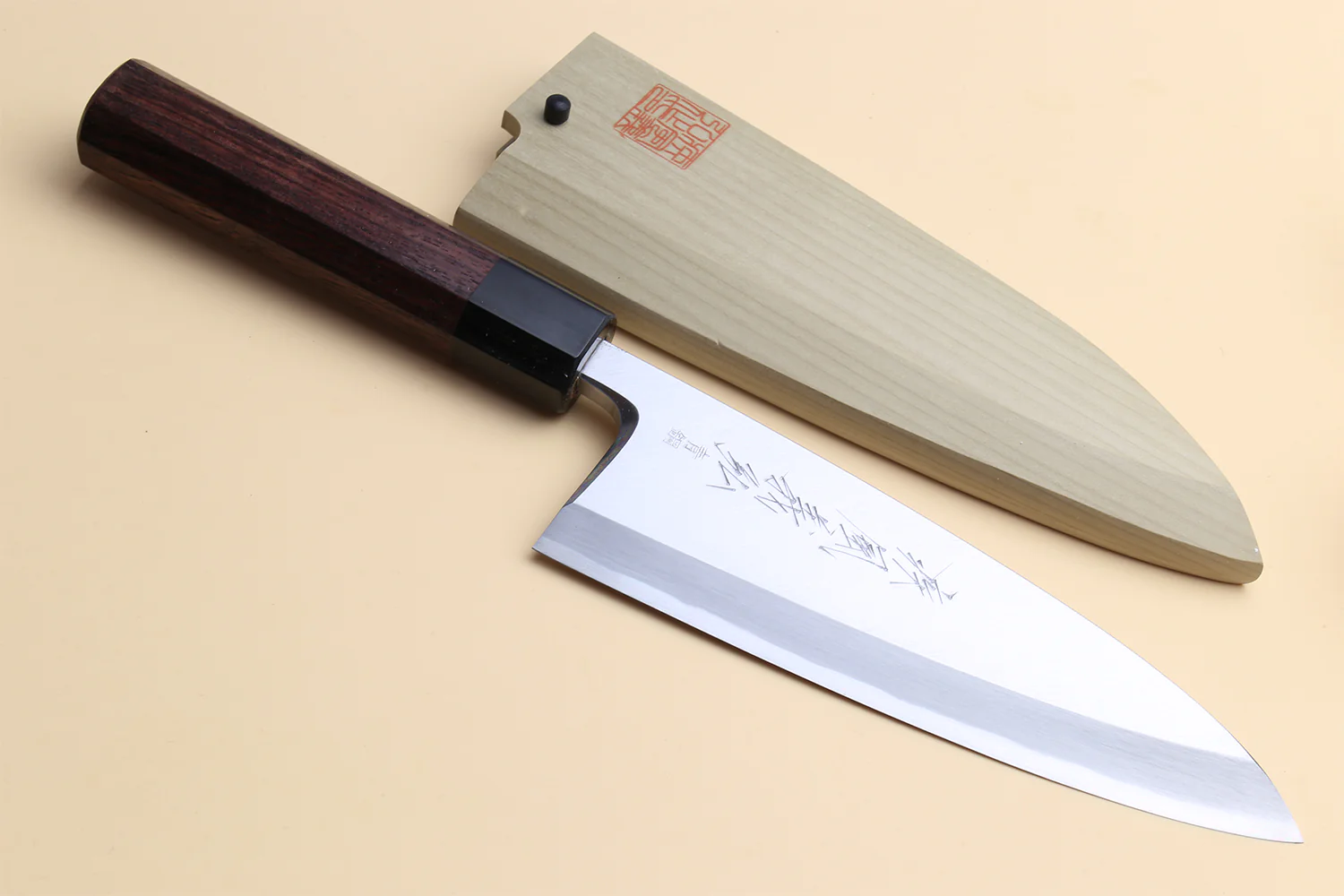
Thank you very much for sharing, I learned a lot from your article. Very cool. Thanks.
Your article helped me a lot, is there any more related content? Thanks!